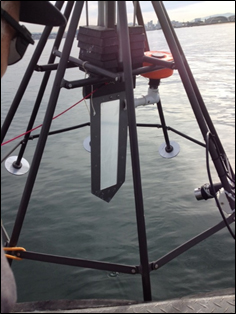Round 1 field sampling completed for study probing origins of sediment contaminants that bioaccumulate in fish

SCCWRP and its partners have completed the first round of field sampling for a two-year study investigating whether legacy contaminants found in the tissue of San Diego Bay fish are coming from contaminated bay sediment or at least partially from somewhere else.
The sampling, completed in June, relies on passive sampling technology to measure the dissolved concentration of sediment-associated contaminants in three locations – just beneath the surface sediment layer, just above the surface layer, and in the water column. Sampling of sediment, fish and zooplankton also was conducted.
The study will probe the veracity of a common assumption in sediment management that all legacy chemical contaminants that have bioaccumulated in fish tissue at a given site originated with contaminated sediment at the site.
Although now-banned chemical contaminants like PCBs and DDTs that have stuck to sediment particles are known to gradually dissolve back into the water column, it is unclear if these contaminants also are being spread extended distances through the water column.
More news related to: Sediment Quality